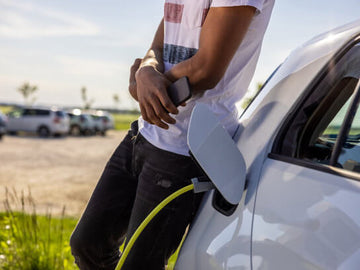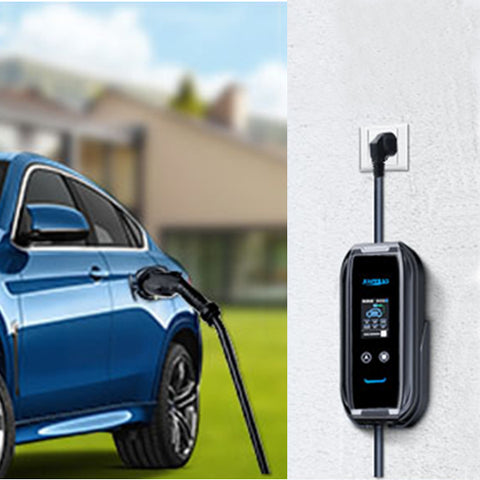
Level 2 chargers are the rockstars of the EV charging world, offering a significant perk for electric vehicle owners: dramatically faster charging times compared to standard Level 1 chargers. But with great speed comes great...electricity usage, right? The question on every EV owner's mind: will a Level 2 charger inflate your electricity bill like a runaway balloon? While it can increase your bill to some extent, it's not a guaranteed skyrocket. Let's delve into the factors at play to see if the convenience of a Level 2 charger outweighs the potential cost impact.
What’s the Relationship Between Charging and Electricity Costs?
Understanding the correlation between charging an electric vehicle (EV) and electricity costs is pivotal for EV owners to manage their expenses efficiently. Here's a breakdown of the key factors:
Electricity Costs: Electricity expenses are typically calculated in kilowatt-hours (kWh) and invoiced based on the total kWh consumed during a billing period. This means that the more electricity used, the higher the cost.
- Impact of Level 2 Chargers: Level 2 chargers are pivotal in this equation. They deliver higher power output compared to Level 1 chargers, potentially reducing the time required to charge an EV. However, this increased power output also leads to a higher kWh consumption per charging session.
- Considerations for EV Owners: When deciding whether to use a Level 2 charger, EV owners must weigh the advantages of faster charging against the associated rise in electricity costs. While Level 2 chargers offer convenience and shorter charging times, they also result in increased kWh usage and, consequently, higher electricity bills.
- Optimizing Charging Practices: To mitigate the impact of higher electricity costs associated with EVSE Level 2 charging, EV owners can implement smart charging strategies. This may involve scheduling charging sessions during off-peak hours when electricity rates are typically lower. By doing so, EV owners can minimize expenses while still benefiting from the convenience of Level 2 charging.
By comprehending the relationship between charging and electricity costs, EV owners can make informed decisions to balance their charging needs with their budgetary constraints effectively.
Factors Affecting the Cost of Charging with a Level 2 Charger
Electricity costs can significantly impact your budget, and understanding how Level 2 chargers affect these costs is crucial. Local rate structures vary, ranging from flat rates to time-of-use pricing, which can influence your overall charging expenses. Staying informed about these rate variations ensures accurate cost estimations, allowing you to budget effectively for your electric vehicle's charging needs.
Assessing Charging Efficiency
Assessing the charging efficiency of your EV is another essential factor in managing electricity costs. Not all energy transferred from the charger reaches the EV's battery; some energy is lost as heat during the charging process. By evaluating your EV's charging efficiency, you can determine how effectively energy is utilized, helping you optimize your charging routine to minimize energy wastage.
Impact of Charging Habits
Your charging habits also play a significant role in determining charging costs. Regular or prolonged Level 2 EV charger usage results in higher overall energy consumption, directly impacting your electricity bill. To mitigate these expenses, consider implementing smart charging features if available. These functionalities enable you to schedule charging sessions during off-peak hours when electricity rates are lower, allowing you to save on charging costs without sacrificing convenience.
Optimizing Charging Costs
To minimize charging expenses, consider leveraging smart charging features if available. These functionalities enable scheduling charging sessions during off-peak hours when electricity rates are lower, thereby reducing costs without compromising convenience.
Environmental Considerations
Moreover, reducing electricity consumption not only benefits your wallet but also contributes to environmental sustainability. Efficient charging practices help lower your carbon footprint, aligning with eco-friendly initiatives aimed at reducing energy consumption and promoting environmental conservation. By optimizing your charging habits and leveraging smart charging technologies, you can lower your charging costs while supporting a cleaner, greener future.
Potential Cost Savings with Level 2 Charging
Level 2 charging offers several potential cost-saving benefits, primarily stemming from shorter charging times and the ability to take advantage of off-peak electricity rates.
One significant advantage of Level 2 charging is the reduced charging time compared to Level 1 chargers. With Level 2 chargers delivering higher power levels, they can recharge an electric vehicle much faster than Level 1 chargers. This shorter charging time can translate into cost savings by minimizing the amount of time your vehicle is connected to the charger, thereby reducing electricity consumption.
Moreover, many utility companies offer time-of-use electricity rates, where electricity prices vary depending on the time of day. Typically, off-peak hours, such as late at night or early morning, have lower electricity rates compared to peak hours during the day. Level 2 chargers, with their faster charging speeds, enable EV owners to take advantage of these off-peak rates by scheduling charging sessions during times when electricity costs are lower. By charging during off-peak hours, EV owners can significantly reduce their charging expenses and potentially realize substantial cost savings over time.
Additionally, some utility companies offer special electric vehicle charging tariffs or incentives to encourage EV adoption and support sustainable transportation. These programs may include discounted electricity rates, rebates, or other incentives specifically designed for EV owners. By utilizing Level 2 chargers, EV owners can maximize their eligibility for these programs and leverage potential cost-saving opportunities provided by their utility company.
Furthermore, Level 2 chargers often come equipped with smart charging features, allowing users to schedule charging sessions and optimize energy usage based on their preferences and electricity rates. These smart charging capabilities enable EV owners to further maximize cost savings by intelligently managing their charging sessions and minimizing electricity expenses.
Level 2 charger offers significant potential cost savings compared to Level 1 charging, thanks to shorter charging times and the ability to capitalize on off-peak electricity rates. By leveraging these advantages and utilizing smart charging features, EV owners can optimize their charging habits, reduce their electricity expenses, and enjoy more affordable and efficient charging experiences.
Managing Costs and Convenience with Level 2 Charging
Level 2 chargers offer faster charging times compared to Level 1 chargers, which can significantly impact your electricity bill. However, understanding electricity rates and managing your charging habits can help mitigate the impact on your expenses.
Firstly, it's essential to familiarize yourself with your local electricity rates. Many utility companies offer different pricing structures, including flat rates and time-of-use plans. By understanding these rates, you can schedule your charging sessions during off-peak hours when electricity costs are lower. This strategic approach can help minimize the impact of Level 2 charging on your overall electricity bill.
Additionally, consider the convenience that comes with faster charging times. While Level 2 chargers may increase your electricity consumption, they also reduce the time your vehicle needs to be connected to the charger. This can be particularly beneficial for busy individuals who rely on their electric vehicles for daily commuting or other activities. The convenience of faster charging times may outweigh the slightly higher electricity costs associated with Level 2 charging.
Moreover, off-peak charging can result in significant cost savings over time. By taking advantage of lower electricity rates during off-peak hours, you can optimize your charging habits to minimize expenses. Smart charging features available in many Level 2 chargers allow you to schedule charging sessions during off-peak times automatically, further enhancing your ability to save on charging costs.
While Level 2 chargers will likely increase your electricity bill to some extent, the impact can be managed by understanding electricity rates and charging habits. By utilizing an efficient Level 2 EV charger like AMPROAD's, you can mitigate costs while enjoying faster charging times. Consider the convenience of off-peak charging, which can lead to significant savings in the long run.
FAQs / People Also Ask
Will using a Level 2 charger significantly increase my electricity bill?
Using a Level 2 charger may lead to a noticeable increase in your electricity bill compared to Level 1 charging. However, the extent of the increase depends on factors such as your local electricity rates, charging efficiency, and charging habits.
How can I minimize the impact of Level 2 charger usage on my electricity costs?
To minimize the impact of Level 2 charger usage on your electricity costs, consider taking advantage of off-peak charging rates if available in your area. Additionally, optimizing your charging habits, such as charging during times of lower electricity demand, can help reduce costs.
Are there any special electricity plans or programs that can help reduce charging costs with a Level 2 charger?
Some utility companies offer special electricity plans or programs tailored for electric vehicle owners. These programs may include discounted rates for EV charging during off-peak hours or incentives for installing home charging equipment.
Does the efficiency of my EV affect the electricity bill when using a Level 2 charger?
Yes, the efficiency of your electric vehicle can affect your electricity bill when using a Level 2 charger. More efficient EVs will require less energy to charge, resulting in lower electricity costs over time.
Are there any potential cost-saving strategies I should consider when using a Level 2 charger?
One potential cost-saving strategy is to invest in a Level 2 charger with advanced features such as scheduling capabilities. This allows you to schedule charging sessions during off-peak hours when electricity rates are typically lower, maximizing cost savings. Additionally, consider monitoring and adjusting your charging habits to align with your utility's rate structure for further savings.





